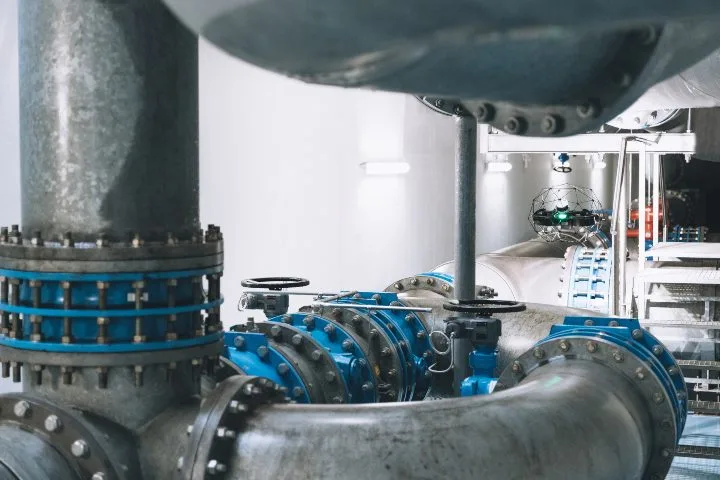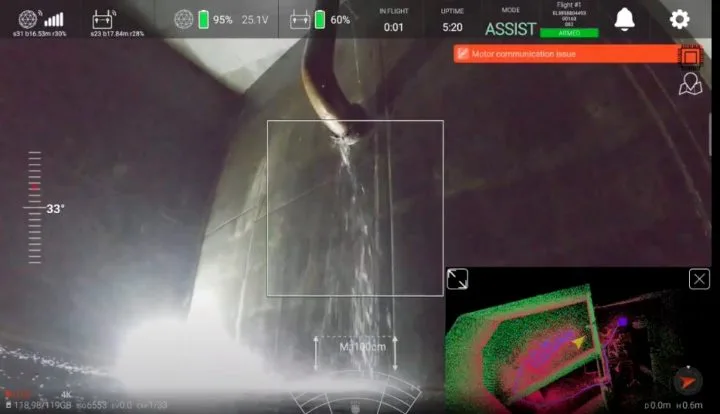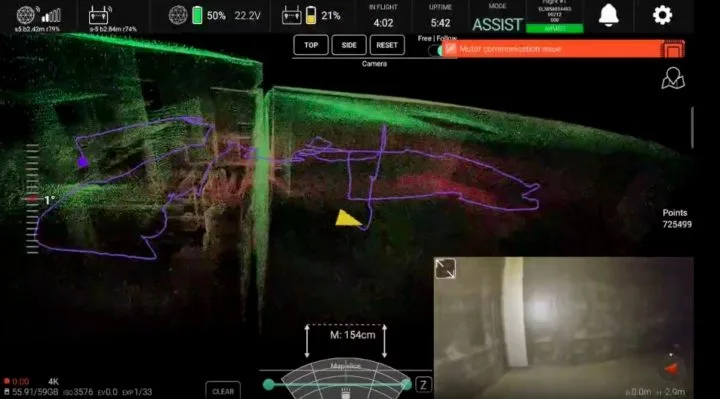Elios 3's Indoor 3D Mapping Aids Lausanne’s Water Department Inspections
Lausanne’s Water Department turned to the Elios 3 to generate accurate 3D maps of its infrastructure, helping them plan more effectively, track changes over time, and carry out essential maintenance tasks.
In a Nutshell: Key Benefits
|
Precise 3D Models The Elios 3’s LiDAR sensor enabled Water Department staff to create detailed 3D maps of their assets, which they utilized for simulations, planning, change tracking, and other maintenance-related activities. |
Defect Monitoring The 3D maps produced by the Elios 3 contain the exact geolocation of any defects found during inspections, allowing inspectors to revisit these locations for future monitoring. |
Enhanced Safety With the Elios 3, inspectors no longer had to put themselves at risk by entering hazardous spaces, thanks to the drone’s ability to collect high-quality visual and LiDAR data.  |
Introduction
The Swiss city of Lausanne is renowned as a hub of innovation. It’s home to the Ecole Polytechnique Fédérale de Lausanne (EPFL), a university that focuses heavily on research and innovation. Each year, EPFL spawns numerous tech startups, many of which choose Lausanne as their base.
Overall, Lausanne houses over a hundred startups, including Flyability. Given its vibrant startup ecosystem, the city frequently taps into the advanced technologies developed within its boundaries, partnering with local companies to integrate new solutions into its operations. As part of this initiative, the Water Department conducted trials with Flyability’s Elios 3 to explore how it could enhance their inspection processes.
Customer Needs
The Water Department manages the entire water cycle for the city, overseeing sewage operations, maintenance, purification, and storage of drinking water. Part of their role involves regular monitoring and upkeep of all water-related assets. This entails periodic inspections to identify defects within the city’s water systems, which might require maintenance or further observation.

The main assets that undergo periodic inspections include:
- Sewage evacuation vaults: Entering these vaults poses risks due to toxic gases, biohazards (such as human waste), and confined spaces. Staff only enter when absolutely necessary, meticulously planning their visits and wearing protective gear to ensure safety.
- Water tanks: Inspecting these tanks, which store drinking water for the city, requires personnel to enter confined spaces. Evaluating the tank slabs also necessitates working at heights on scaffolding, adding another layer of risk.
Other assets regularly inspected include storm overflows, spillways, drinking water reservoirs, manifolds, ovoid tanks, and evacuation collectors. During inspections, tracking the progression of defects over time is critical. Common concerns include waste buildup, structural collapses, and overall asset integrity.
Inspectors revisit previously identified defect locations to assess whether they’ve worsened. Accurately locating each defect is vital for effective monitoring and preventing further deterioration.
Solution
Inspectors at Lausanne’s Water Department decided to test the Elios 3 for the following purposes:
- Generate detailed 3D models of internal spaces within assets to aid maintenance work, including recreating the original structure and monitoring changes over time using the model as a digital twin.
- Pinpoint the exact location of each defect found during inspections, enabling inspectors to return to the precise spot where a defect was initially detected using a 3D model generated by Elios 3 data.
- Boost safety by eliminating the need for confined space entry and work at height on scaffolding.
Results
Over six months, the Water Department employed the Elios 3 for various inspections.

The trial missions proved successful, meeting all requirements for 3D mapping, remote data collection, and pinpointing defect locations for precise long-term monitoring.
“The Elios 3’s 3D maps let us model any structure we need—whether it’s a storm overflow or a drinking water reservoir. We can then use these maps for simulations, reconstruct the original structure accurately, and track the exact location of defects we discover during inspections.â€
- Sébastien Ramelet, Project Manager Engineer/Water Protection Inspector for the City of Lausanne Water Department
Two examples of inspections carried out with the Elios 3 include:
1. Tank Slab Inspection
The Water Department completed a tank slab inspection with the Elios 3 in half a day, reducing the time required from five days. Much of that time was spent constructing and dismantling scaffolding. Since the Elios 3 could fly into the tank and collect data remotely, scaffolding wasn’t necessary, making the inspection both quicker and safer.
2. Storm Spillway Inspection
The Water Department used the Elios 3 to inspect a storm spillway, creating a 3D model of the structure. Inspectors remained above ground while gathering data, avoiding the hazards associated with entering the spillway.
The 3D model generated from the Elios 3’s LiDAR data was instrumental in creating a simulation of the storm spillway, aiding the Water Department in making maintenance decisions.

Through these and other inspections, the Water Department experienced several advantages from using the Elios 3 in its inspection work:
- Precise 3D Maps. The Elios 3’s 3D maps offered valuable data for tracking defect locations and simulating wastewater structure performance over time.
- Long-Term Defect Monitoring. The Elios 3’s 3D maps allow inspectors to geolocate every defect found during an inspection, enabling them to revisit the exact spot in the future, greatly enhancing their ability to monitor defects. Additionally, the video footage from the Elios 3 lets inspectors return to specific locations within an asset and view what it looked like on a particular date, providing deeper insights into how the asset has changed over time.
- Safety Improvements. The Elios 3 enabled inspectors to avoid entering dangerous confined spaces or working at heights for data collection, significantly boosting safety in their work.
- Time Efficiency. The Elios 3 reduced the time needed for several inspections the Water Department performs. For instance, a tank inspection went from one week to half a day, saving four and a half days of work by eliminating the need for scaffolding.
- User-Friendly. Personnel at the Water Department who had no prior drone experience quickly learned to operate the Elios 3 after less than an hour of training.
- Data Quality. The Elios 3’s visual data matched the quality of what an inspector could gather but with additional benefits like full coverage and storage of all collected data in 4K. A person might overlook a defect or forget its location and appearance.

Conclusion
The Water Department of Lausanne has chosen to permanently adopt the Elios 3 for its internal inspections, alongside traditional visual inspections. Their extensive testing phase allowed them to develop their drone program and associated practices, enabling them to implement regular use of the Elios 3 across their maintenance efforts.
Over time, the 3D models created with the Elios 3 will lead to substantial improvements in monitoring structural changes, establishing a permanent digital record of defect locations and developments that will extend the lifespan of their assets.
Drink & Wine Label,Wine Bottles Label,Living Wine Labels,Champagne Labels
Jiangmen Yingzhihui Electronic Commerce Co., LTD , https://www.yzhprint.com